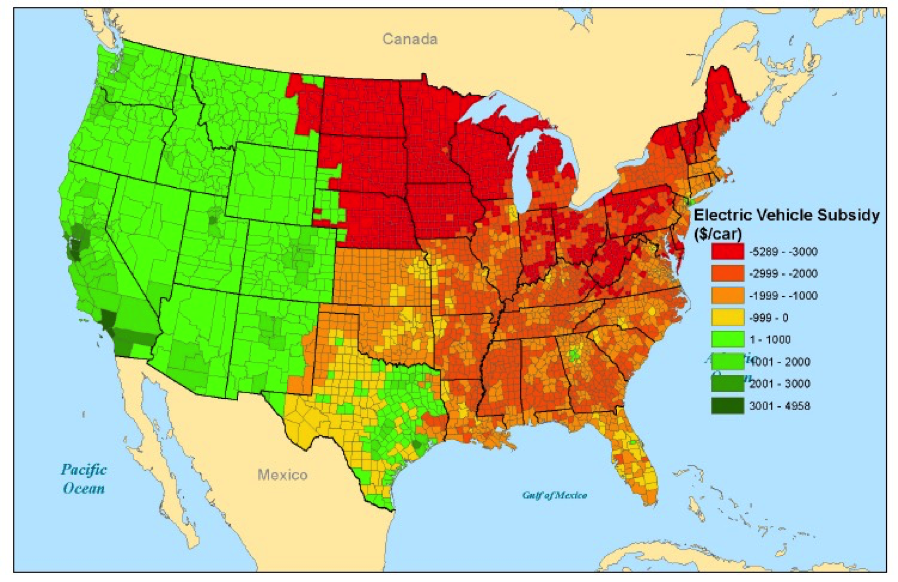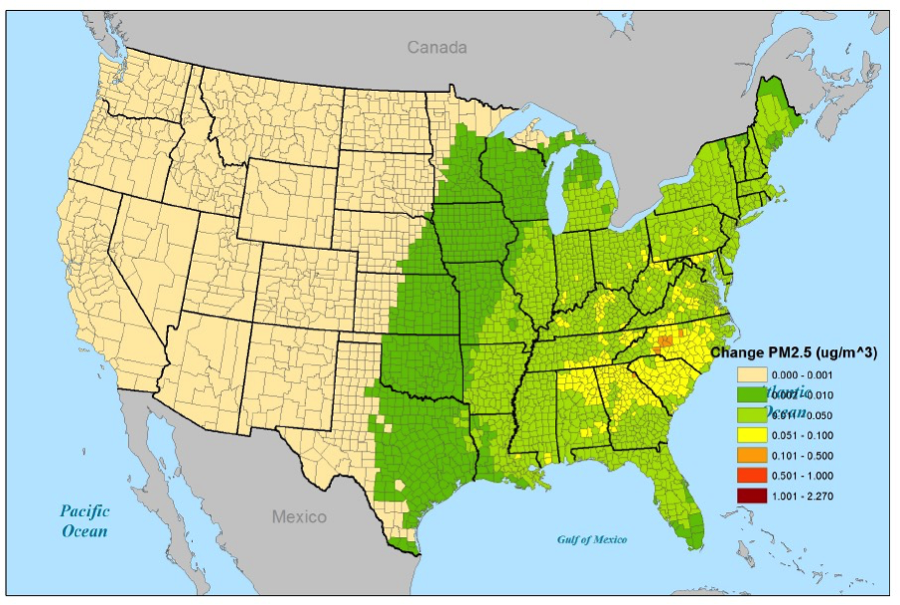Electric cars are often advertised as “zero emission vehicles”. Although it is true that they don’t have tailpipes, electric cars are charged from the electrical grid, and most electric power plants release air pollution emissions through their smokestacks. So which is cleaner, tailpipes or smokestacks?
As with real estate valuation, the answer depends on three factors: location, location, location. In this context, location matters because: (1) the fuel used to produce electricity varies regionally, (2) the population exposure offset by electric vehicles depends on city versus rural driving, and (3) the extent to which emissions from each vehicle cross political boundaries, and therefore benefit different constituencies, also varies by location.
Figure 1 shows the environmental benefit of driving an electric Ford Focus rather than a gas-powered Ford Focus in each county in the United States. In the green shaded counties, the electric car generates positive environmental benefits- damages from air pollution are lower than what would have been generated had the gas car been driven instead. In the red shaded counties, the electric car generates negative environmental benefits, implying the electric car generates more damages from air pollution than the gas car.
Figure 1. County-level environmental benefit

The environmental benefit is large and positive (around $5000) in Los Angeles. The electric grid in the west is a relatively clean mix of hydro, nuclear, and natural gas power plants. And emissions from a gasoline car driven in Los Angeles affect a large number of people living in the city and surrounding counties. These conditions are reversed in Fargo, North Dakota. The population is much smaller, and the eastern electric grid is heavily dependent on coal. Correspondingly, the environmental benefit is large and negative (around -$5000).
These results come from our recent paper. To obtain them we combine (i) a statistical model of the relationship between electricity demand and emissions from smokestacks and (ii) a scientific model of pollution dispersion in the atmosphere and the subsequent harm to humans and the environment.
A defining characteristic of our work is that we consider both global and local pollution. Global pollution comes from emissions of carbon dioxide. An environmentally concerned citizen that turns to the Internet to learn about the benefits of electric cars is likely to turn up one of the many studies that focus only on carbon dioxide emissions. These studies show that in most places in the country an electric car generates less carbon dioxide emissions than a gasoline car. We find this as well. But, including emissions of local pollution such as particulate matter can reverse the environmental benefit of the electric car, as happens in much of the eastern U.S.
Studying local pollution leads to another important insight. Electric cars export pollution across state lines to a much greater degree than gasoline cars. This is illustrated in Figures 2a and 2b. Figure 2a shows the dispersion of particulate matter pollution from a fleet of gasoline Ford Focus cars driven in Fulton County Georgia. Most of the pollution is concentrated in the half dozen counties around Fulton County (which encompasses the city of Atlanta). A small amount is exported to nearby states. Figure 2b shows the dispersion of particulate matter pollution from charging a fleet of electric Ford Focus cars in Fulton County Georgia. The geographic footprint of the pollution encompasses almost the entire east coast. This is due to the interconnected nature of the electricity grid. An increase in demand for electricity in Fulton County can affect the production in electricity in a power plant many states away.
Figure 2a: Increase in PM2.5 from driving gasoline cars in Fulton County

Figure 2b: Increase in PM2.5 from charging electric cars in Fulton County

The pollution export phenomena we identify creates dilemmas for environmentally concerned citizens as well as policymakers. In just about every state, driving an electric car improves the air quality in that state, relative to a comparable gasoline vehicle, but decreases the air quality in nearby states. This may entice concerned citizens to purchase electric cars and policymakers to subsidize these purchases, even in places where electric cars generate overall negative environmental benefits to society.
There are several important caveats to our work. First, we only consider emissions of pollution from driving gas cars and charging electric cars. We do not consider upstream emissions associated with drilling and refining oil into gasoline, mining coal or drilling for natural gas to provide fuel for electric power plants, or manufacturing the vehicles. Prior research shows that electric cars have slightly greater upstream costs due to battery manufacturing. Second, our data on grid emissions is the latest available, but corresponds to the years 2010-2012. There is an ongoing transformation from coal to natural gas generation in the electricity industry and this is only partially captured in our results.
One hundred years ago, electric cars had around a 30 percent market share. They quickly lost out to gasoline cars. The last five years have seen a modest comeback, with market shares inching up to around one per cent in many countries. Electric car enthusiasts believe that these vehicles will help solve our air pollution problems. Our work illustrates the importance of cleaning up the electricity grid before that vision can be achieved.
♣♣♣
Notes:
- This blog post is based on the authors’ paper Are There Environmental Benefits from Driving Electric Vehicles? The Importance of Local Factors, in American Economic Review, Vol. 106, No. 12, December 2016, pp. 3700-3729
- The post gives the views of its author, not the position of LSE Business Review or the London School of Economics.
- Featured image credit: Electric car charging point, by Frank Hebbert, under a CC-BY-2.0 licence
- Before commenting, please read our Comment Policy.






Whilst it is true that using electric cars that have been charged by electricity generated by coal is still adding carbon to the atmosphere. It is still more efficient to centrally burn coal to charge a battery in an electric car, than it is to burn petrol or diesel in thousands of separate engines. If the shift to the electrification of transport happens before the grid moved to renewable energy, then the benefits will be seen before and after this event, and before it will still be more efficient.
You can see the shift from the grid to renewable energy is happening. Its just not fast enough, tesla have produced a product called the Tesla Powerwall. It is a rechargeable lithium-ion battery, that stores energy generated by domestic homes. Until home energy storage becomes more common, its difficult to see residential properties shifting from the grid.